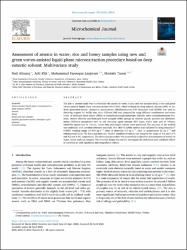| dc.contributor.author | Altunay Nail | |
| dc.contributor.author | Elik Adil | |
| dc.contributor.author | Lanjwani, Muhammad Farooque | |
| dc.contributor.author | Tüzen, Mustafa | |
| dc.date.accessioned | 2023-04-12T05:44:35Z | |
| dc.date.available | 2023-04-12T05:44:35Z | |
| dc.date.issued | 2022 | tr |
| dc.identifier.citation | Nail Altunay a
, Adil Elik a
, Muhammad Farooque Lanjwani b,c
, Mustafa Tuzen b,d,*
a Sivas Cumhuriyet University, Faculty of Science, Department of Chemistry, Sivas, Turkey b Tokat Gaziosmanpasa University, Faculty of Science and Arts, Chemistry Department 60250 Tokat, Turkey c Dr M. A. Kazi Institute of Chemistry, University of Sindh, Jamshoro, Sindh, Pakistan d King Fahd University of Petroleum and Minerals, Research Institute, Centre for Environment and Marine Studies, Dhahran 31261 Saudi Arabia | tr |
| dc.identifier.uri | https://hdl.handle.net/20.500.12418/13588 | |
| dc.description.abstract | The aim of present study was to determine the arsenic in water, honey and rice samples using a new and green vortex-assisted liquid phase microextraction (VA-LPME), which is based on deep eutectic solvent (DES) by hydride generation-atomic absorption spectrometry. Ethylenediamine-N,N'-disuccinic acid (EDDS) was used as chelating reagent for As(III) ions. Four different DES was prepared by using different combination and molar ratios of hydrogen bond donor (HBD) as benzyltriphenylphosphonium chloride, tetra-n-butylammonium bromide, choline chloride and hydrogen bond acceptor (HBA) groups as ethylene glycol, glycerol and diethanolamine. Different parameters such as pH, chelating agent amount, DES types, molar ratio and its volume, emulsifier agents and its volume, vortex time and sample volume were optimized. The accuracy of the method was confirmed with certified reference materials. The DES-VA-LPME method was validated by using linearity r2 0.9985, working range 20–600 ng L−1, limit of detection 6.5 ng L−1, limit of quantitation 20 ng L−1 and enhancement factor 70. Intra and inter day relative standard deviation was found in the range of 3.6 and 4.1% and 4.2 and 4.9%, respectively. The developed procedure was successfully utilized for determination of arsenic in water, honey and rice samples. The factorial design was used to investigate the individual and combined effects of variables as well significant and insignificant effects. | tr |
| dc.language.iso | eng | tr |
| dc.rights | info:eu-repo/semantics/closedAccess | tr |
| dc.subject | Vortex-assisted liquid phase microextraction Deep eutectic solvent Arsenic Water Honey and rice samples Hydride generation-atomic absorption spectrometry Factorial design | tr |
| dc.title | Assessment of arsenic in water, rice and honey samples using new and green vortex-assisted liquid phase microextraction procedure based on deep eutectic solvent: Multivariate study | tr |
| dc.type | article | tr |
| dc.contributor.department | Fen Fakültesi | tr |
| dc.relation.publicationcategory | Uluslararası Hakemli Dergide Makale - Kurum Öğretim Elemanı | tr |















